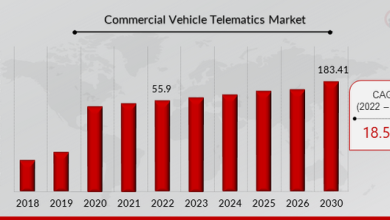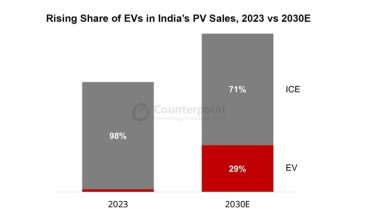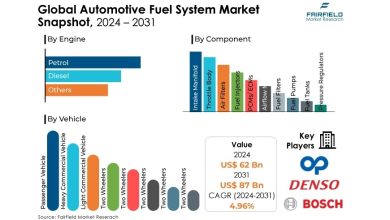Global connected vehicle market to surge at 14.7% CAGR
Visiongain has published a new report entitled Connected Vehicle Market Report 2024-2034. Connected Vehicle market was valued at US$82.67 billion in 2023 and is projected to grow at a CAGR of 14.7% during the forecast period 2024-2034.
Urbanization and Smart City Initiatives Spur Demand for Connected Mobility Solutions
Urbanization trends and the proliferation of smart city initiatives are driving the integration of connected vehicle technologies into urban transportation systems. Connected vehicles can interact with smart infrastructure, traffic management systems, and other vehicles to optimize traffic flow, reduce congestion, and improve overall urban mobility. As cities worldwide embrace smart transportation solutions, the demand for connected vehicles equipped with advanced connectivity features is expected to grow significantly. Connected vehicle technologies play a pivotal role in the transformation of urban transportation systems. By integrating vehicles with smart infrastructure, traffic management systems, and other vehicles, cities can unlock a range of benefits that enhance urban mobility and improve quality of life for residents.
How has COVID-19 had a significant negative impact on the Connected Vehicle Market?
The COVID-19 pandemic has had a significant impact on the connected vehicles market, influencing both demand and supply dynamics across the industry. On the demand side, the economic uncertainties and mobility restrictions imposed during the pandemic led to a temporary slowdown in vehicle sales and adoption of new automotive technologies. Consumers, facing financial uncertainties and prioritizing essential spending, deferred discretionary purchases, including connected vehicles, thereby affecting market growth. Additionally, lockdown measures and remote work arrangements reduced the need for daily commuting, dampening the demand for connected mobility solutions.
Moreover, supply chain disruptions caused by the pandemic, including factory closures, material shortages, and logistics challenges, disrupted the production and delivery of connected vehicle components and systems. Automotive manufacturers faced delays in sourcing critical components such as semiconductors, sensors, and communication modules, impacting production schedules and leading to inventory shortages. These supply chain disruptions not only affected the rollout of new connected vehicle models but also hindered aftermarket installations and retrofits of connected vehicle solutions.
How will this Report Benefit you?
Visiongain’s 447-page report provides 131 tables and 202 charts/graphs. Our new study is suitable for anyone requiring commercial, in-depth analyses for the global connected vehicle market, along with detailed segment analysis in the market. Our new study will help you evaluate the overall global and regional market for Connected Vehicle. Get financial analysis of the overall market and different segments including network, connectivity solutions, software, V2X communication, and component and capture higher market share. We believe that there are strong opportunities in this fast-growing connected vehicle market. See how to use the existing and upcoming opportunities in this market to gain revenue benefits in the near future. Moreover, the report will help you to improve your strategic decision-making, allowing you to frame growth strategies, reinforce the analysis of other market players, and maximise the productivity of the company.
What are the Current Market Drivers?
Growing Demand for Driving Assistance System Driving the Market Growth
The growing demand for driving assistance systems is emerging as a significant driving force propelling the expansion of the connected vehicles market. This surge in demand can be attributed to several factors contributing to the overall market growth. Firstly, there’s a heightened emphasis on enhancing road safety and reducing accidents, leading to increased adoption of advanced driver assistance systems (ADAS). These systems leverage connectivity and sensor technologies to provide real-time alerts, warnings, and automated interventions to assist drivers in avoiding collisions, navigating traffic, and maintaining safe driving behaviour.
Advancements in Connectivity Technology Driving the Market Growth
Advancements in connectivity technology are playing a pivotal role in driving growth within the connected vehicles market. The rapid evolution of wireless communication protocols, such as 5G, Wi-Fi 6, and Bluetooth Low Energy (BLE), has significantly enhanced the capabilities of connected vehicles, enabling faster data transmission, lower latency, and greater reliability. These advancements are facilitating seamless communication between vehicles, infrastructure, and external systems, laying the foundation for a wide range of innovative applications and services.
Where are the Market Opportunities?
Intelligent Transportation System to Provide Opportunities for the Global Connected Vehicles Market
Market opportunities abound for the global connected vehicles market, driven by various factors that promise growth and innovation within the industry. One significant opportunity lies in the adoption of intelligent transportation systems (ITS). These systems integrate advanced technologies such as IoT, AI, and big data analytics to enhance the efficiency, safety, and sustainability of transportation networks. Connected vehicles can communicate with infrastructure, other vehicles, and transportation management systems in real-time by leveraging ITS. This enables features like traffic management, predictive maintenance, and optimized routing. This integration not only improves the overall transportation experience but also opens up new avenues for the connected vehicle market to expand its offerings and cater to evolving consumer needs.
On 28 June 2023, ZTE Corporation and Tianyi Transportation Technology unveiled the industry’s first 5G+ intelligent connected vehicle system with Vehicle-Road-Cloud integration. This occurred at the Mobile World Congress (MWC) Shanghai 2023.
Collaboration and Partnership Between Market Player
Collaboration and partnerships between market players present another lucrative opportunity for market growth. As the connected vehicle ecosystem continues to evolve, collaboration among automotive OEMs, technology companies, telecom providers, and start-ups becomes essential to drive innovation, develop interoperable solutions, and address complex challenges such as cybersecurity and data privacy. By fostering strategic alliances and joint ventures, market players can leverage each other’s strengths, share resources, and accelerate the development and deployment of connected vehicle technologies, ultimately enhancing their competitiveness and market reach.
26 March 2024, A branch of IDEMIA Group, IDEMIA Secure Transactions (IST) is a top supplier of payment and connectivity solutions to banks, cellular network providers, and automakers. It has made a name for itself as a pioneer in safe payment methods for digital currencies issued by central banks (CBDCs).
Competitive Landscape
The major players operating in the connected vehicle market are Aptiv PLC, AT&T Inc, Continental AG, Intellias Limited, Karma Automotive LLC, Mercedes-Benz Group AG, Microsoft Corporation, Panasonic Holdings Corporation, Qualcomm Incorporated, Robert Bosch GmbH, Sierra Wireless, Inc., Tesla, Inc., Verizon Communications Inc., Visteon Corporation, Zubie, Inc. These major players operating in this market have adopted various strategies. These strategies comprise M&A, investment in R&D, collaborations, partnerships, regional business expansion, and new product launch.




